More Related Content
What's hot (20)
Voltage and Current Source foe Circuits and Networks

Voltage and Current Source foe Circuits and Networks
Viewers also liked
3rd to 8th semester Electronics and Communication Engineering (2010 Scheme) S...

3rd to 8th semester Electronics and Communication Engineering (2010 Scheme) S...BGS Institute of Technology, Adichunchanagiri University (ACU)
Viewers also liked (20)
Circuit Network Analysis - [Chapter1] Basic Circuit Laws![Circuit Network Analysis - [Chapter1] Basic Circuit Laws](data:image/gif;base64,R0lGODlhAQABAIAAAAAAAP///yH5BAEAAAAALAAAAAABAAEAAAIBRAA7)
![Circuit Network Analysis - [Chapter1] Basic Circuit Laws](data:image/gif;base64,R0lGODlhAQABAIAAAAAAAP///yH5BAEAAAAALAAAAAABAAEAAAIBRAA7)
Circuit Network Analysis - [Chapter1] Basic Circuit Laws
Electronic devices-and-circuit-theory-10th-ed-boylestad-chapter-4

Electronic devices-and-circuit-theory-10th-ed-boylestad-chapter-4
Electronic devices-and-circuit-theory-10th-ed-boylestad-chapter-3

Electronic devices-and-circuit-theory-10th-ed-boylestad-chapter-3
Electronic devices-and-circuit-theory-10th-ed-boylestad-chapter-5

Electronic devices-and-circuit-theory-10th-ed-boylestad-chapter-5
3rd to 8th semester Electronics and Communication Engineering (2010 Scheme) S...

3rd to 8th semester Electronics and Communication Engineering (2010 Scheme) S...
Basic electronics and electrical first year engineering

Basic electronics and electrical first year engineering
Similar to Circuit Analysis-
Similar to Circuit Analysis- (20)
Thevenin norton and max power theorem by ahsanul hoque

Thevenin norton and max power theorem by ahsanul hoque
More from Ammara Javed
More from Ammara Javed (17)
Circuit Analysis-
- 2. Introduction: Thevenin’s theorem is a popular theorem, used often for analysis of electronic circuits. This theorem states that a linear circuit containing one or more sources and other linear elements can be represented by a voltage source and a resistance. Using this theorem, a model of the circuit can be developed based on its output characteristic. It was discovered in 1883 by French telegraph engineer Léon Charles Thévenin.
- 3. Through the use of thevenin theorem , we have the ability to reduce the complex circuit down to a simple series circuit .
- 4. The four steps involved are: 1- First Remove the load. 2- Then determine the voltage seen by the load (Vth). 3- Then replace the voltage source with a short. 4- At the end determine the resistance seen by the load (Rth).
- 5. 1- Remove the load:
- 6. 2- Determine the voltage seen by the load (Vth): Since R2 is not connected at one end as it does not carry any current. Hence it cannot have a voltage drop, the voltage is present only across R3 Vth=VR3
- 7. 2- Determine the voltage seen by the load (Vth): Vth=(R3/R3+R1)*Vs
- 8. 3- Replace the voltage source with a short:
- 9. 4- Determine the resistance seen by the load (Rth): Find the total resistance from the open terminal side which is called thevinin equivalent resistance (Rth) by removing actual voltage source from the circuit. Rth=R2+(R1*R3/R1+R3)
- 11. Conclusion: • Certain circuits can be simplified by using Thevenin’s Theorem. • Equivalent Resistance is essential for the calculation of TEC. • Ohm’s law is useful in this theorem. • A linear network can be transferred into a voltage source.
Editor's Notes
- Thévenin's theorem Thévenin's theorem

